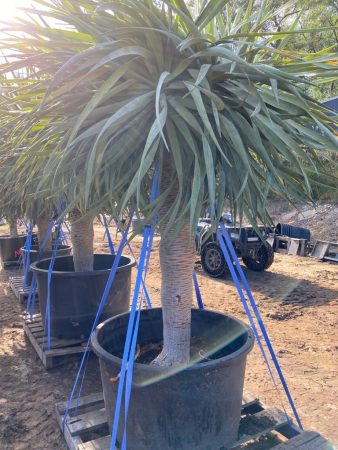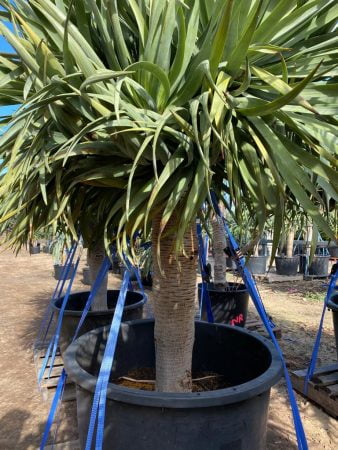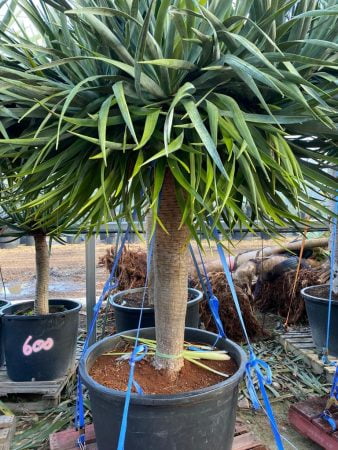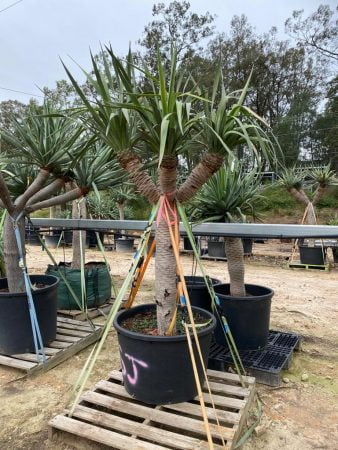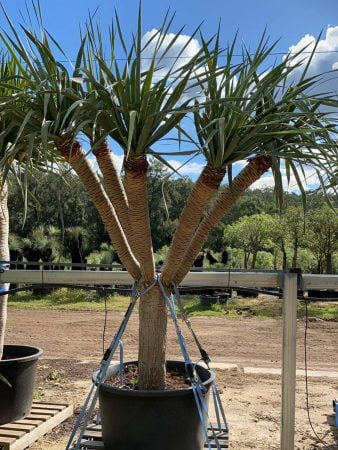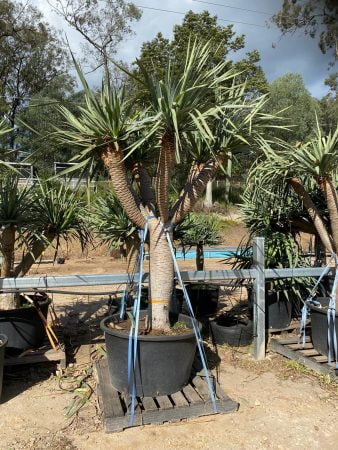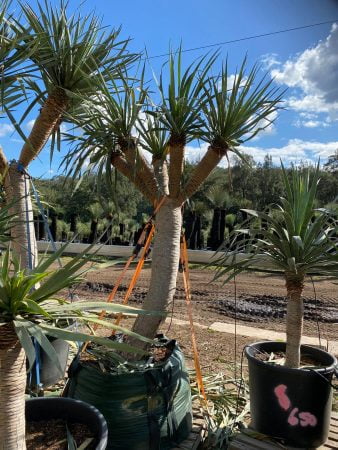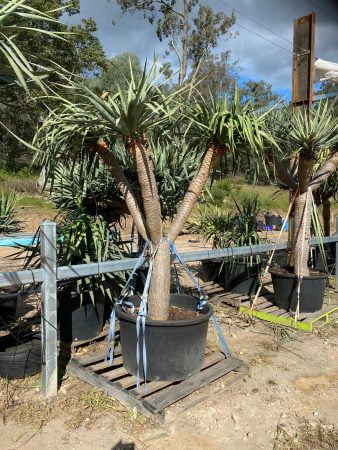Dragon Tree
Dragon Tree (Dracaena draco)
| Scientific name: | Dracaena draco |
|---|---|
| Common names: | Dragon Tree, Dragon’s Blood Tree, The Canary Island Dragon Tree, Drago. |
| Synonyms: |
|
| Genus: | Dracaena (From Greek ‘drakaina‘ meaning a female dragon – a reference to the reddish resin that exudes from the bark and leaves, supposedly resembling dragon’s blood) |
| Mythology: | The Dragon Tree appears as part of the Greek myth ‘The Eleventh Labour of Hercules: The Apples of the Hesperides’. The story tells that a hundred-headed dragon was slain, its red blood flowing upon the land. It was from this blood stained land that the Dragon Trees sprung. |
| Overview: | The Dragon Tree is a sub-tropical plant native to the Canary Islands, Cape Verde, Madeira and Western Morocco. It is so valued in Tenerife that it has been chosen as the Natural Symbol of the island. Unfortunately it has become a threatened species in the wild. |
About Dragon Trees
Dracaena draco, The Dragon Tree is a wonderful specimen tree that is hugely popular with landscapers because of its naturally strong architectural features.
Being evergreen, drought tolerant and able to live for hundreds of years it is a popular choice of feature plant in homes and gardens across Australia. It is more, cold tolerant than other Dracaena species so will happily grow in cooler as well as warmer climates, due to its tolerance of lower light levels, it can also make a stunning house or office plant- a real eye-catcher!
The Dragon Tree is a sub-tropical plant native to the Canary Islands, Cape Verde, Madeira and Western Morocco. It is so valued in Tenerife that it has been chosen as the Natural Symbol of the island. Unfortunately, it has become a threatened species in the wild.
When grown in perfect conditions the Dragon Tree can grow to around 10-12 metres in height with a spread of up to 4 metres. Tall, clear trunks are topped with shaggy, rounded heads of long, sword-shaped leaves which add wonderful elements of sound, movement and texture to the garden. They make an excellent alternative to Palm Trees.
We have one of the largest ranges of Dragon Trees in Australia with a mixture of single or multi-crown specimens available at various sizes and ages.
Single-crown trees look fantastic when planted in groups – a small forest of Dragon Trees – whereas multi-headed specimens make excellent standalone feature trees. Whatever the look you are after, we are always happy to assist with the thoughtful design of your landscape.
Frequently Asked Questions
How tall can a dragon tree grow?
When grown in best conditions, dragon trees can reach 10-12 metres in height.
Continue reading about Dragon Tree care.
Do dragon trees need much water?
When planted in the ground a dragon tree should not require any watering. For container grown dragon trees, water regularly to keep the soil moist. But, as mentioned earlier, do not allow the soil to become waterlogged as this will cause the roots to rot.
Continue reading about Dragon Tree care.
How can I propagate a dragon tree?
Dragon Trees can be propagated by seed or cutting. Semi-hardwood cuttings and leafless stem sections can be rooted in spring.
Continue reading about Dragon Tree care.
Where can I buy a dragon tree?
We are one of the leading suppliers of Dragon Trees in Australia. We are fully licensed by the NSW Office of Environment and Heritage to sustainably harvest several species and we are proud to say that we have one of the largest ranges of Dragon Trees.
Click here to get a quote.
Dragon Tree: Planting
When choosing a site for your Dragon Tree it is important to bear in mind that it is a long-living tree that, when grown in the best conditions, can reach 10-12 metres in height. The multi-headed specimens make excellent feature trees in a dry or water-wise garden scheme or, as a centrepiece in a courtyard or patio area. Single-crown trees look fantastic when planted in groups but they will become multi-headed as they age.
It also makes a great house or office plant due to its tolerance to lower light levels.
It prefers a bright planting position in full sun or part shade and can be grown either in the ground or in a planter. A sheltered spot, away from harsh winds, is preferred but not essential.
The Dragon Tree is not fussy when it comes to soil conditions so it can be planted in any loose, well-drained soil. The only requirement to be aware of is that it does not like to have its roots set in water, therefore good drainage is essential.
When planting in the ground, sand or gravel can be added to the planting hole if the natural soil is heavy. In a pot, incorporate the sand or gravel into the potting mix and raise the pot slightly off the ground so that the water can run freely away from the base.
These practices will help to aid drainage and prevent root rot.
Although Draco is one of the hardier species of Dracaena it can only tolerate low temperatures (such as a slight frost) for a short period of time. 5-10C is considered a minimum safe temperature. It is drought-tolerant once established and is also considered to be salt tolerant.
Dragon Tree: Ongoing Care and Maintenance
Minimal ongoing care and maintenance are required as the Dragon Trees are generally pest and disease-free and, being drought tolerant when planted in the ground should not require any watering.
For container-grown plants, water regularly to keep the soil moist. But, as mentioned earlier, do not allow the soil to become waterlogged as this will cause the roots to rot.
Pot-grown Dragon Trees should be fed with a controlled/slow-release fertiliser every 6-8 months. Well-fed plants can develop a reddish tinge to the leaves. Take care that container-grown trees do not become too top-heavy by repotting them into a larger container every year or two. This will ensure they don’t get blown over and damaged. It is noted that Dracaena draco thrives when slightly pot-bound.
No pruning is required but as the older leaves die off they form a ‘skirt’ around the trunk which can be removed. Old flower stalks can also be cleared away by cutting a few centimetres above where the stalk emerges – take care not to damage any new buds nearby, as these are the developing new branches.
Dragon Tree: Propagation
Dragon Trees can be propagated by seed or cutting.
Seeds should be sown shallowly into a free-draining potting mix in Spring. Cover the seeds with a fine layer of sand or grit. This will help to keep the seed in contact with the potting mix. Keep moist but do not water excessively and keep at a temperature of around 18-21C.
Semi-hardwood cuttings and leafless stem sections can be rooted in spring. Branched sections of a stem that are removed at the node can be taken at lengths as much as a metre long. Cuttings are best planted into a sandy potting mix and positioned in full sun. The application of bottom heat will improve the success rate. Taller cuttings should be staked to ensure they don’t fall and care should be taken when handling them to prevent any damage to the growing tip.
Dragon Tree: Taxonomy and Naming
Family: Asparagaceae
Genus: Dracaena (From Greek ‘drakaina‘ meaning a female dragon – a reference to the reddish resin that exudes from the bark and leaves, supposedly resembling dragon’s blood)
Species: draco (From Latin ‘draco’, ultimately from the ancient Greek ‘drakon’ meaning dragon)
Synonyms:
- Asparagus draco
- Palma draco
- Yucca draco
- and many more.
Common names: Dragon Tree, Dragon’s Blood Tree, The Canary Island Dragon Tree, Drago.
Dragon Tree: History
The Dragon Tree is the Natural Symbol of the island of Tenerife. It was valued so much on the island that The Guanches (the Aboriginal inhabitants of the Canary Islands) worshipped one of the larger trees on the island and even hollowed out its trunk to create a small sanctuary inside. This particular specimen was observed by Alexander von Humboldt, the famous German explorer, as being 21m tall and 14 m in circumference and he estimated its age to be 6000 years old. Unfortunately, it was destroyed by a storm in 1868.
Another specimen called ‘El Drago Milenario’ (The Thousand Year Old Dragon), growing in the Parque del Drago in North West Tenerife is the oldest and largest known plant of this species. Having over 300 main branches it is reported that when it flowered in 1995 it had around 1800 flowering stems – this huge amount of flowers increased its weight by an estimated 3.5 tonnes when it came to the fruiting season!
It has also been hollowed out and contains a six-metre-high cavity, accessible by a door. It even has a fan installed to provide ventilation and prevent fungal growth. Its massive trunk is made wider by clusters of aerial roots which grow from the bases of the lower branches down the trunk to the soil below.
The age of El Drago Milenario is highly disputed. It is thought to be around 800-1000 years old. A 1907 estimate by Professors from the Polytechnic School of Zurich put it at 2500 years old but, in 1975, its age was re-estimated at 250-365 years old. Certainly not the couple of thousand that had been previously claimed.
El Drago Milenarino was depicted on the 1,000 peseta note, is part of the coat of arms for the Icod de los Vinos municipality and, it appears in many local legends. It was declared a national monument in 1917 and is considered so special that in 1993 a nearby road was re-routed – presumably to protect the root structure. It has been submitted to UNESCO as a World Heritage candidate.
The Dragon Tree appears as part of the Greek myth ‘The Eleventh Labour of Hercules: The Apples of the Hesperides’. The story tells that a hundred-headed dragon was slain, its red blood flowing upon the land. It was from this blood-stained land that the Dragon Trees sprung.
Dragon Tree: Distribution and Habitat
The Dragon Tree is native to the Canary Islands, Cape Verde, Madeira and Western Morocco where it grows in a wide variety of soils and situations.
It was introduced to Australia by seed in the early colonial days.
Dragon Tree: Appearance
The Dragon Tree is a naturally architectural, evergreen tree that can’t help but stand out in a landscape. It has a thick trunk topped with single or multiple heads of linear, sword-shaped blue-green leaves that grow to around 60cm in length.
Although the Dragon Tree is a monocot, it develops a branching growth pattern with age. All growth occurs on a single stem when young, then, at around 10-15 years this stem stops growing and produces a flower spike with panicles of greenish-white, fragrant flowers. The flowers are followed by orange/red berries in Autumn. Soon after flowering, a crown of terminal buds appears and the plant starts to branch. Each branch again grows for 10-15 years then flowers and re-branches giving mature plants an umbrella-like habit. The age of a Dragon Tree is estimated by the number of branching points it has grown.
Ultimately, the Dragon Tree can grow as high as 10-12 metres tall, with a spread of around 2.5-4m. This can take from 20-50 years as this tree is quite slow growing. It takes approximately 10-15 years to reach a height of 1.2 metres but it can grow faster depending on conditions.
Dragon Tree: Ecology
The fruit of The Dragon Tree was once eaten by a dodo-like, flightless bird, endemic to the Canaries that is now extinct. The passing of the seeds through the digestive tract of this bird stimulated germination. Therefore it is thought that the extinction of this bird may have played a role in the decline in Dragon Trees growing naturally in the wild.
Dragon Tree: Conservation
Dracaena draco is listed on the International Union for Conservation of Nature (IUCN) Red List as ‘Species Vulnerable or Habitat Critically Threatened’.
Dragon Tree: Uses
The Dragon Tree exudes a reddish-coloured resin, one of several sources of a substance known as Dragon’s Blood. Dragons blood has many uses as a dye or varnish and has been used in works of art, as a wood stain on the famous Stradivarius violins and also, because of its antioxidant properties, as a varnish for iron tools.
Dragons blood has anti-viral, anti-bacterial and anti-fungal properties and therefore has a number of traditional medicinal uses. Its anti-oxidant properties have led to its use in modern cosmetics for anti-ageing creams and studies are being carried out to verify reports of its suspected anti-cancer properties. It was also used by the Guanche people of the Canary Islands for embalming the dead.
Request A Quote Now.
Call Us For An Instant Quote!
Australia:
0461 486 193
International:
+61 461 486 193
Email – hello@designertrees.com.au

